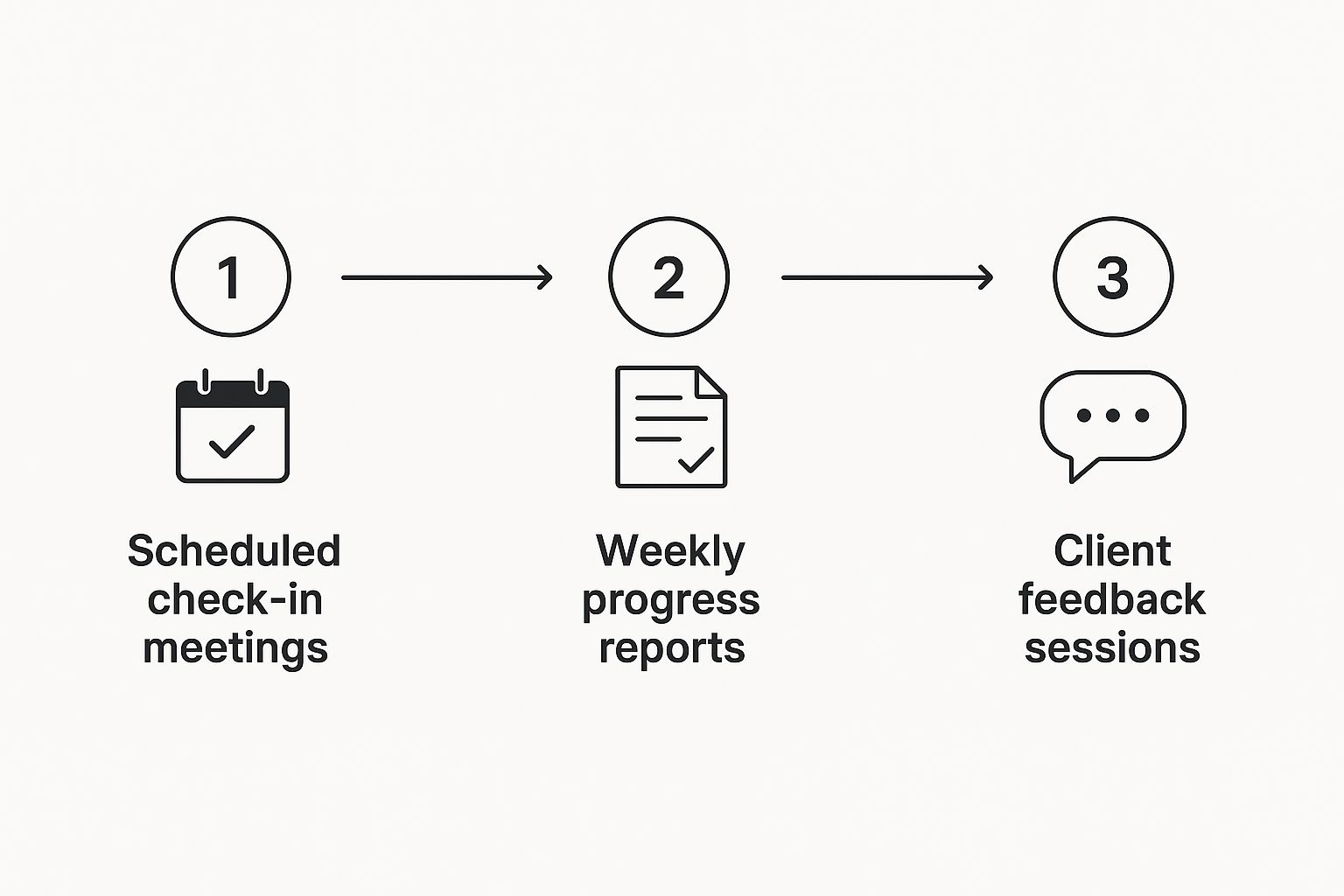Setting and managing client expectations isn't just a box to check—it's the very foundation of a successful project. It's about getting ahead of potential issues by defining the scope, communicating with absolute clarity, and being realistic from the get-go. This is what separates a dream partnership from a project that spirals into a nightmare.
The Hidden Costs of Unmet Expectations

Before we jump into the "how," let's talk about the "why." Letting client expectations run wild isn't a small hiccup; it’s a direct hit to your agency’s bottom line and your team's morale. When goals are fuzzy and communication breaks down, the fallout can be massive.
When you don’t set clear boundaries, scope creep is almost a guarantee. That one "tiny tweak" the client asks for quickly turns into a mountain of extra work. Suddenly, your profit margins are shrinking, deadlines are flying by, and your team is burning out on what was supposed to be an exciting project.
The Financial and Reputational Damage
The numbers don't lie. Poor customer experiences cost businesses a staggering $3.7 trillion across the globe every year. Think about that. And with 80% of customers saying the experience they have with a company is just as important as its products, the pressure is on.
Get it wrong, and over half of those customers will walk away after just one bad interaction. That's a huge risk.
But it’s not just about the money you lose on one project. An unhappy client isn't going to be singing your praises or sending referrals your way—and we all know referrals are the lifeblood of an agency. Worse, they might share their bad experience, slowly chipping away at the reputation you’ve worked so hard to build.
Mismanaged expectations don't just cost you a project; they can cost you future opportunities. The goal is to create brand advocates, not cautionary tales.
The Long-Term Impact on Partnerships
At the end of the day, failing to manage expectations poisons the client relationship itself. It kills trust and turns a creative collaboration into a constant battle. This is a topic worth exploring further, and you can find a comprehensive guide on managing client expectations that breaks down some great foundational strategies.
Managing expectations isn't just about being nice; it's a core business strategy. It protects your profits, saves your team's sanity, and helps you build the kind of long-term, trusting partnerships that fuel real growth. If you're interested in diving deeper, we also have a guide on https://www.softriver.co/blog/how-to-build-customer-trust-proven-strategies-for-success. By laying down a clear framework from day one, you’re not just finishing a job—you’re investing in your agency's future.
Building Your Foundation Before Kickoff

The best way to manage client expectations is to set them before a single design file is ever created. I've learned this the hard way. The discovery and onboarding phase isn't just about paperwork; it's where you build the trust and clarity that will carry the entire project.
Trying to rush this part is like building a house without a blueprint—it’s just asking for trouble later on.
Your first conversations need to go way beyond the deliverables list. You have to uncover the client's unspoken assumptions and find out what "success" actually looks like to them. A client might say they want a "modern logo," but that could mean a hundred different things. Your job is to translate that vague request into a solid, shared vision.
Digging Deeper with the Right Questions
To get past those surface-level requests, you have to ask questions that get to the heart of their business goals. This is how you find out what really matters.
Here are a few questions I always make sure to ask:
- What specific business problem are you hoping this new branding will solve?
- Imagine this project is a massive success one year from now. What does that look like?
- What are your absolute must-haves for this project to be a win?
- Are there any past experiences with agencies, good or bad, that we should know about?
These questions shift the conversation from a checklist of items to real-world outcomes. The answers you get will become the bedrock of your project plan and help you pull together a much stronger creative brief. For more on that, check out our guide on how to write a creative brief that gets results.
Crafting a Rock-Solid Scope of Work
Once you have a deep understanding of their vision, it's time to document everything in a detailed Scope of Work (SOW). Think of this document as your project's constitution; it's your single best defense against scope creep. A vague SOW is just an open invitation for misunderstandings.
A great Scope of Work doesn't just list what's included; it clearly states what is not included. This single practice can save you from countless headaches and awkward conversations down the line.
Your SOW needs to be crystal clear, leaving zero room for interpretation. It’s the document you and your client will both turn to when questions or new requests pop up mid-project.
To make your SOW truly effective, make sure it explicitly details:
- Deliverables: The final assets the client will receive (e.g., three initial logo concepts, a comprehensive brand style guide in PDF format, and a social media template kit).
- Revisions: The exact number of revision rounds included for each deliverable. I’ve found that including two rounds is a good starting point.
- Timeline: Key milestones and deadlines, making sure to include dates for when you need client feedback to keep things on track.
- Communication: How and when you'll communicate. Will it be weekly email updates? Bi-weekly check-in calls? Set the cadence now.
When you invest this time upfront, you create a shared understanding that prevents so many problems. It turns what could be a simple transaction into a genuine partnership built on transparency from day one.
Mastering Proactive and Transparent Communication
Once the project kicks off, clear and consistent communication is your best friend. It’s not about overwhelming your client with constant emails, but about establishing a predictable rhythm. This simple act eliminates surprises and builds a ton of confidence.
When clients know exactly when and how they'll hear from you, they feel like they're part of the team, not just someone waiting on the sidelines.
Decide on this rhythm together, right from the start. Maybe a weekly summary email is perfect. Or perhaps a quick, 15-minute check-in call every other week makes more sense. Getting this locked in early prevents those random "just checking in" messages and keeps everyone in sync without derailing your creative flow.
Creating a Communication Rhythm
Let's be real—clients today expect more. A recent 2024 Global State of CX report found that 68% of experts say customer expectations are higher than ever, and 43% notice clients are more impatient. This means your communication needs to be proactive and personal to make them feel valued.
A simple, structured communication loop can make all the difference. It ensures that your formal meetings, written updates, and feedback sessions all work together to keep the project transparent.

The whole point of proactive communication is to answer your client’s questions before they even think to ask them. A simple status report that's on time, every time, builds more trust than a grand, sporadic presentation.
Choosing the right communication mix is key to setting this rhythm. Not every project needs a daily stand-up, and a monthly email might be too infrequent for a fast-moving design sprint.
Here’s a look at how different communication types can work for different situations.
Communication Cadence Comparison
Ultimately, the best approach is the one that you and your client agree on and can stick to. Consistency is what builds trust and keeps everyone on the same page.
Navigating Difficult Conversations
Even the most buttoned-up project will hit a bump in the road. A timeline might slip, a technical issue pops up—it happens. How you deliver that news is what truly defines the client relationship.
The trick is to bring up bad news early, be completely honest about it, and always come with a solution.
For instance, instead of just saying, "We're running behind," try this: "We've hit an unexpected snag with the API integration that will likely add two days to the development timeline. To keep the launch on track, our team is going to work on the user interface in parallel. Here’s the updated milestone chart."
This approach does three things: it shows you're taking ownership, it presents a clear plan forward, and it reinforces your commitment to their success. If you want to dig deeper, check out these client communication best practices for agencies.
By blending regular updates with honest problem-solving, you turn communication from a simple to-do list item into a powerful tool for keeping clients happy for the long haul.
How to Handle Scope Creep Gracefully

We’ve all heard it. That seemingly innocent phrase that sends a shiver down every project manager's spine: “Could you just add one more little thing?”
That, right there, is scope creep. And if you let them pile up, those "little things" will quietly eat away at your timeline and your profit margins.
But here’s the thing: scope creep doesn’t have to be a fight. When you have a clear, professional process for handling it, you can turn these moments into opportunities. You can actually reinforce your value and, in many cases, increase the project budget. It’s all about setting firm but fair boundaries from the get-go.
Triage Every New Request
First things first, you need to quickly figure out what you’re dealing with. Not every out-of-scope request is a five-alarm fire. You just need a system to tell the difference between a tiny tweak and a major change that needs a formal sit-down.
When a new request comes in, immediately ask yourself these questions:
- Is this actually outside the deliverables we both signed off on in the Scope of Work?
- Will this take more than, say, 30 minutes of unplanned time from anyone on the team?
- Could this change throw off other project milestones or push back the final deadline?
If you answer "yes" to any of these, it's time to hit pause. You need to have a conversation with the client before a single minute of work is done. This isn't about being rigid; it's about protecting the project's original goals that you both agreed to.
The most powerful tool you have against scope creep is your original Scope of Work. Refer back to it not as a weapon, but as a mutual agreement you’re both working to protect.
Frame the Conversation Positively
How you respond in that moment is everything. A blunt "no, that's not in the scope" can feel adversarial. Instead, you want to frame the conversation around protecting their investment and getting them the best possible result.
A simple, positive email script can open the door without shutting down their idea.
Try something like this:
“That’s an interesting idea! I’ve reviewed our original scope, and this new feature falls a bit outside of what we initially planned. I’d be happy to put together a quick proposal outlining the additional time and cost to get this done right for you. Shall we schedule a brief 15-minute call to discuss?”
This approach is effective because it does a few things really well:
- It validates their idea: It shows you're listening and taking them seriously.
- It references the SOW: This is a gentle, professional reminder of the boundaries you agreed on.
- It offers a solution: You're not saying no. You're showing them the path forward.
By turning a potential conflict into a productive discussion, you stay in control and position yourself as their strategic partner. For a deeper dive into controlling this kind of unintended growth, check out these strategies for Mastering Project Scope Creep Management. Learning to navigate these requests is a crucial skill for making sure every project is a win-win.
Finishing Strong: Project Delivery and Offboarding
How you end a project is just as important as how you start it. I've seen it happen too many times: a fantastic project gets soured right at the end by a rushed or sloppy handover. It leaves the client feeling confused and a little abandoned.
To really manage expectations from start to finish, you need a thoughtful, professional offboarding process. This isn’t just about zipping up some files and sending the final invoice. It's your last, best chance to prove the value you delivered, cement the relationship, and open the door for future work. A strong finish makes your client feel empowered, not overwhelmed.
The Project Wrap-Up Meeting
The heart of a great offboarding experience is the project wrap-up meeting. Please, don't just send a quick email. Schedule a proper call to celebrate the wins, get some honest feedback, and formally close out the engagement.
Think of it as the project’s grand finale. The goal here is to circle back to the initial objectives and show them exactly how the work you did solved their problems. It’s a powerful way to remind them of the journey and the incredible value they just received.
A well-executed offboarding meeting transforms a simple transaction into a lasting partnership. This is where you get those killer testimonials, ask for a case study, and plant the seeds for repeat business down the road.
Empowering Your Client for Success
A smooth handover is all about preventing that frantic "Where do I find...?" or "How do I use...?" email a week after you've wrapped. You want to empower your clients to use the amazing assets you’ve created with total confidence.
Your handover package should be more than a link to a Dropbox folder. I always try to include a few key things to make their lives easier:
- A quick training video: A simple screen recording showing them how to use brand templates or navigate the final file structure can save hours of back-and-forth.
- A "What's Next" guide: Just a simple document outlining how to start implementing the new branding and what they might expect in the first few weeks. It's a simple touch that shows you're thinking ahead for them.
- A clear support policy: Let them know how to reach out for help and what's included post-project. Are you available for a few quick questions, or is that a new retainer? Be clear.
This proactive approach manages their expectations about your future availability and proves you’re invested in their long-term success. The entire journey, including this final step, is absolutely vital. In fact, the global customer experience management market was valued at USD 12.04 billion in 2023 and is projected to grow massively, which just goes to show the financial impact of a positive client experience. You can dig into more insights on the customer experience market's growth on grandviewresearch.com.
When you finish this strong, you don't just complete a project; you create a brand advocate. You leave your client feeling great about their investment, armed with everything they need to succeed, and genuinely excited to work with you again. That, right there, is the ultimate goal.
Common Questions About Setting Client Expectations
No matter how buttoned-up your process is, you're going to run into tricky situations. That's just part of the job. Knowing how to navigate these moments is what separates the pros from the rest. Let's walk through some of the most common challenges I've seen pop up time and time again.
These moments can definitely test your patience, but if you handle them with a calm, professional hand, you can actually turn a potential conflict into a moment that builds even more trust with your client.
What’s the Single Most Important Document for Managing Expectations?
Hands down, it’s the Scope of Work (SOW). This document is your project's constitution, your single source of truth. It’s so much more than a simple to-do list; its real power comes from being incredibly clear and detailed.
A rock-solid SOW needs to spell everything out, leaving no room for assumptions:
- Deliverables: What, exactly, are you creating for them?
- Exclusions: What is not included? This is often more important than what is.
- Timelines: Key milestones and deadlines for both of you.
- Revision Rounds: The specific number of revisions included for each major deliverable.
- Communication: How and when will you connect?
When this is signed off on before any design work starts, it becomes the foundation for the entire project. It gives you a non-confrontational way to handle requests that fall outside the plan without making things personal or awkward.
Think of the SOW less like a weapon and more like a mutual agreement. It’s there to protect both of you and make sure you’re always rowing in the same direction.
How Do I Handle a Client Who Constantly Goes Dark?
A client who disappears can derail a project faster than anything else. Your timelines get wrecked, your workflow grinds to a halt, and momentum is lost. The trick here is to be proactive, not reactive.
You have to address this possibility right in your initial contract. I always include a clause stating that feedback is needed within a specific timeframe, usually 48-72 business hours, to keep the project on schedule. This sets a clear, professional boundary from the very beginning.
If a client does go quiet, don't just sit around and wait. Send a polite but firm email that clearly explains two things:
- The specific feedback you're waiting for.
- The direct impact their delay will have on the project timeline.
You could say something like, “Hi [Client Name], just following up here. To make sure we hit our target launch date of [Date], I’ll need your final feedback on the homepage mockups by the end of the day Friday. Any delay past that will unfortunately push our development start date back.” If the silence continues, don't be afraid to pick up the phone. A quick call is often the fastest way to get things moving again.
What's the Best Way to Reset Expectations Mid-Project?
Sometimes, things just go off the rails. It happens. Maybe a few small "can you just..." requests have snowballed, or the client’s vision has completely changed. When you feel that shift, you have to act fast to get everyone aligned again.
The best way to do this is to schedule a dedicated "Project Realignment" meeting. Don't frame it as a crisis. Instead, position it as a positive, strategic check-in to make sure everyone is still on the same page and working toward the same goals.
In the meeting, gently walk them through the original SOW and the goals you all agreed on. Then, show them where the project is now and open up a discussion about the new requests or challenges that have popped up. The goal is to work together on a documented plan to move forward. This might mean adjusting the timeline, creating a formal change order for the new work, or simply re-prioritizing what's left to be done.
Being transparent and collaborative is everything in these moments. By tackling the issue head-on, you not only get the project back on track but also prove you’re a strategic partner who has their back.
Ready to build a brand that commands respect and credibility from day one? At Softriver, we specialize in creating custom brand identities with unmatched speed and quality. Get your professional brand identity in just 48 hours and set the right impression from the very beginning.







